-
Welcome back Guest! Did you know you can mentor other members here at H-M? If not, please check out our Relaunch of Hobby Machinist Mentoring Program!
- Forums
- THE PROJECTS AREA
- PROJECT OF THE DAY --- WHAT DID YOU DO IN YOUR SHOP TODAY?
- Project of the Day Mega-Thread Archives
You are using an out of date browser. It may not display this or other websites correctly.
You should upgrade or use an alternative browser.
You should upgrade or use an alternative browser.
2018 POTD Thread Archive
- Thread starter 2volts
- Start date
Made some Mitchell plates today and ended up ordering a vacuum fixture plate to make more. I didn’t mount my other vise because I wouldn’t be able to machine the sides and was getting chatter on the ends. I did later put blocking on each side and I got some very nice finishes.


- Joined
- May 10, 2017
- Messages
- 1,199
Accidentally double posted.
That happened to me a few minutes ago also
Well, I finally got to try out my newly fabbed power vacuum yesterday, and it was a bit of a train wreck.
First, I use a pin to hold the motor/blower to the mower, and the hole the pin goes through is just a little too small, so it was a hassle to get it in and out (naturally, it wasn't a problem to do this at home).
Second, it's very top heavy, particularly with the hose on top of it. When I have more time, I think I'll rework the frame & wheels to give it a wider wheelbase, and lower the rear part of the frame a couple inches to help with this a bit, but I've got a feeling that this will be an ongoing issue. I will switch to storing the hose in the truck until I need it, and only put it on the vacuum then.
Third, as part of being top heavy, I had forgotten to install the bags for holding debris in the bagger, so I got the ones from the mower. But, the ground the vacuum was one wasn't level like my garage is, so when I opened the bagger and put the support brace on that holds it up, the hoses pulled it open even more (which the brace doesn't stop, because it wouldn't do this if the hoses weren't on it). So, it tips over, and with both the added mass of the hoses and momentum, the plastic housing ripped free from the pins being used as hinges (there was a pretty small amount of plastic "under" the pin, so it didn't take much to do this. This was the show-stopper for using it, as the housing wouldn't sit properly on the frame anymore, and a bunch of debris would just blow out the edges instead of staying in the bags.
So, today I fashioned some new hinges to attach to the housing, which should do the trick.
Here's some pics of the original "hinge" in the plastic that failed:
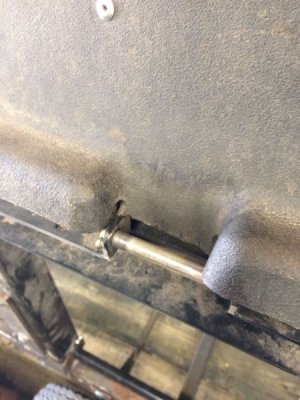
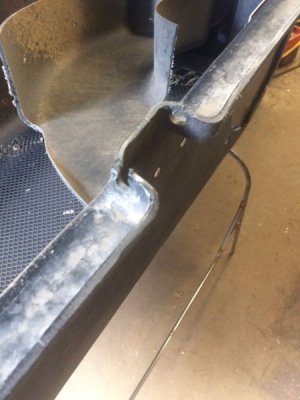
And here's the mostly-finished result. I'll probably add a third bolt in the middle of each of them, and am considering adding some "wings" to the hinge area, so I can bolt the narrow horizontal part of the housing to the hinge as well (to prevent the flat plastic area where the hinge is bolted to from tearing away from the rest of the housing during use).
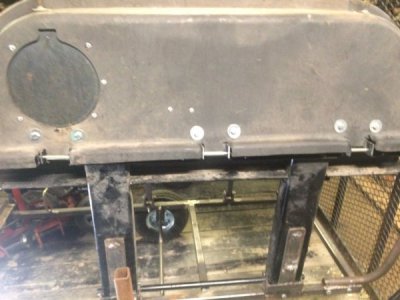
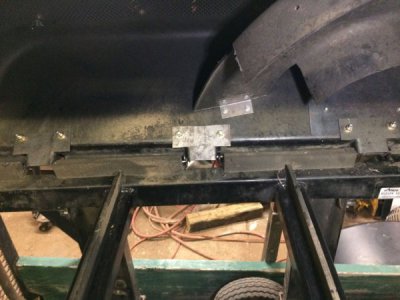
I also will be adding some limiting straps to each end of the housing, so it can't open up more than just past what is needed for the housing support.
I also had some issues with the new hose and angled nozzle that is used on the mower. Even though that angled nozzle weighs over 5lbs, and the nozzle it goes on is pointed a little upwards, the air pressure the blower generates is enough to blow it off. Same with the hose that goes on the angled nozzle.
So, I put a hose clamp on the hose, and added a clip that I robbed from the 6" hose setup I'm no longer using to hold the angled nozzle on securely.
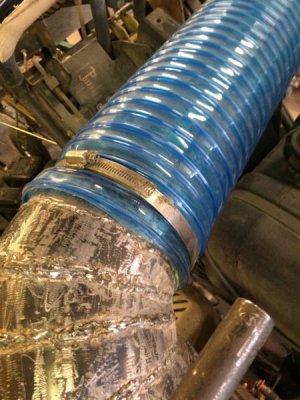
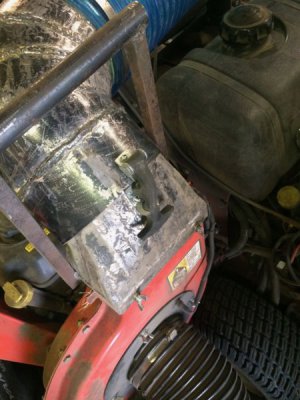
First, I use a pin to hold the motor/blower to the mower, and the hole the pin goes through is just a little too small, so it was a hassle to get it in and out (naturally, it wasn't a problem to do this at home).
Second, it's very top heavy, particularly with the hose on top of it. When I have more time, I think I'll rework the frame & wheels to give it a wider wheelbase, and lower the rear part of the frame a couple inches to help with this a bit, but I've got a feeling that this will be an ongoing issue. I will switch to storing the hose in the truck until I need it, and only put it on the vacuum then.
Third, as part of being top heavy, I had forgotten to install the bags for holding debris in the bagger, so I got the ones from the mower. But, the ground the vacuum was one wasn't level like my garage is, so when I opened the bagger and put the support brace on that holds it up, the hoses pulled it open even more (which the brace doesn't stop, because it wouldn't do this if the hoses weren't on it). So, it tips over, and with both the added mass of the hoses and momentum, the plastic housing ripped free from the pins being used as hinges (there was a pretty small amount of plastic "under" the pin, so it didn't take much to do this. This was the show-stopper for using it, as the housing wouldn't sit properly on the frame anymore, and a bunch of debris would just blow out the edges instead of staying in the bags.
So, today I fashioned some new hinges to attach to the housing, which should do the trick.
Here's some pics of the original "hinge" in the plastic that failed:


And here's the mostly-finished result. I'll probably add a third bolt in the middle of each of them, and am considering adding some "wings" to the hinge area, so I can bolt the narrow horizontal part of the housing to the hinge as well (to prevent the flat plastic area where the hinge is bolted to from tearing away from the rest of the housing during use).


I also will be adding some limiting straps to each end of the housing, so it can't open up more than just past what is needed for the housing support.
I also had some issues with the new hose and angled nozzle that is used on the mower. Even though that angled nozzle weighs over 5lbs, and the nozzle it goes on is pointed a little upwards, the air pressure the blower generates is enough to blow it off. Same with the hose that goes on the angled nozzle.
So, I put a hose clamp on the hose, and added a clip that I robbed from the 6" hose setup I'm no longer using to hold the angled nozzle on securely.


- Joined
- Dec 27, 2014
- Messages
- 4,060
Summer, and model flying season is coming. I can tell, I got an order about the middle of the week, for some props, Not the first hits year, but the largest. These props are finished by the buyer, he/she carves/sands them to an approximate airfoil form and applies a finish to them, The largest ones (19 3/8" here,) take me about an hour apiece when I consider manufacture of the hinges, too. The smallest (six inches) about 4 minutes. There's 31 of them there. They are balsa, the ones with brown bands have a basswood hub in the middle and a hinge on each end of the hub, so they fold back against the fuselage when done spinning.
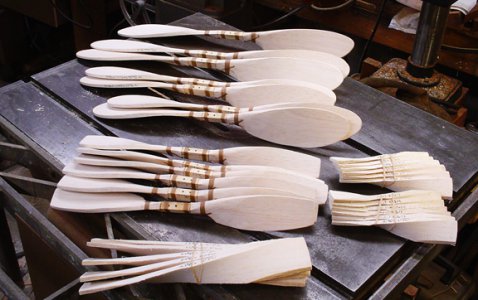
The brown bands are thread, up to 20 wraps each, to keep the assembly together.
Edit: correct grammer

The brown bands are thread, up to 20 wraps each, to keep the assembly together.
Edit: correct grammer
Last edited:
- Joined
- Feb 1, 2015
- Messages
- 9,647
Tom, how do you do the twist; steamed?
- Joined
- Dec 27, 2014
- Messages
- 4,060
Tom, how do you do the twist; steamed?
To misquote Mark Twain, "the machine is a product of the principles of the inclined plane and the lever..."
Really it's more like a vertical profile mill. The cutting action is done by a somewhat stationary (it oscillates up and down) sanding roll, 7/8 dia 3" long spinning at 10,300 rpm.
The work is held in two clamps (one at each end) in a carriage that traverses left and right, rotating as it goes. The rotation is driven by a cam at the back with a follower which rotates the carriage.
In the following picture the spin motor is off to the left (belt drive) the spindle in is the middle, on the right is a stepper motor which oscillates the spindle. The motor on the left raises and lowers the spindle to allow it to cut front and back.
At the bottom of the picture you can see the top of the carriage and a single blade being cut. No, having been started. I stopped the machine to take the picture. The round column on the left is a drill press behind the machine.
The rail behind the sanding roll has on it four profiles, the top one simply tapers from wide left to thin right. The blade in the machine is one half of a pair which will be glued to the hub. The front pattern is simply a rough cut, no profile for heavy (thick) props. The other two profiles are taperd wide in the middle thin at the ends for one piece propellers.
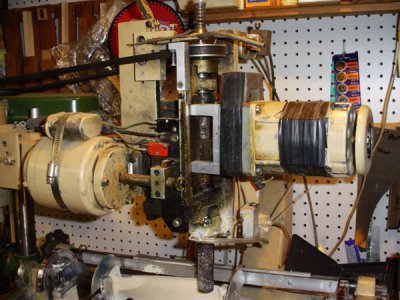
I wish I could take credit for developing it, but I just run it and keep it in repair.
Small bladles under 9 inches generally take two passes front and back, longer sometimes take 5 each side.
The blade in the picture is 13/16 thick, 2" wide and about 7 inches long. I can cut props up to 17 inches long on this machine.
- Joined
- Feb 1, 2015
- Messages
- 9,647
An interesting piece of machinery. Is the general design patterned after a machine to cut full size props or was it developed for the model aircraft industry?
Can you vary the prop pitch?
Thanks for sharing!
Can you vary the prop pitch?
Thanks for sharing!
- Joined
- Dec 27, 2014
- Messages
- 4,060
Is the general design patterned after a machine to cut full size props or was it developed for the model aircraft industry?
Can you vary the prop pitch?
I have no idea how full scale props are made, that's beyond my pay grade.
Pitch. I have cams (we call them templates) from 7 to 26 pitch, 7 through 14 for left hand pitch. We have a spreadsheet to develop the curve for the pitch, but there are problems with it. With it I input the pitch required, print a full sized curve, transfer it to 1/16 aluminum then tweak to develop the correct profile, (cut a prop and check the pitch every half inch, then file the template to bring it into correctness.)
Did some of my first rigid tapping on my fadal and boy it worked great. That is a 3/4 deep 1/4-20 tapped hole in 6061. Excuse my brothers commentary and the awful video quality. I’m hoping to start making some better videos but I just don’t have the time at the moment. Hopefully the YouTube video link will work


![IMG_20180428_124904[1].jpg IMG_20180428_124904[1].jpg](https://www.hobby-machinist.com/data/attachments/223/223550-09ca82e9434f029784002538f20e5eb4.jpg)
![IMG_20180428_133122[1].jpg IMG_20180428_133122[1].jpg](https://www.hobby-machinist.com/data/attachments/223/223551-7bbe76f254cff2892677bd25e0ccb4e7.jpg)
![IMG_20180428_133721[1].jpg IMG_20180428_133721[1].jpg](https://www.hobby-machinist.com/data/attachments/223/223552-888945fb3c887acee372a3b596ecca56.jpg)
![IMG_20180428_134527[1].jpg IMG_20180428_134527[1].jpg](https://www.hobby-machinist.com/data/attachments/223/223553-320304f3ec727cc49c2548047cb71673.jpg)